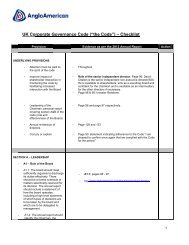pdf [ 1.1MB ] - Anglo American
pdf [ 1.1MB ] - Anglo American
pdf [ 1.1MB ] - Anglo American
Create successful ePaper yourself
Turn your PDF publications into a flip-book with our unique Google optimized e-Paper software.
there is also the need for the generation of energy tobe environmentally acceptable. Climate change andenergy security are key concerns of the coal industry.We are currently engaged in promotion of andresearch into clean coal technologies. Furtherinformation on <strong>Anglo</strong> Coal’s approach to climatechange can be found in our global sustainabledevelopment report.Community relationshipsThe <strong>Anglo</strong> <strong>American</strong> Socio-Economic AssessmentToolbox (SEAT) is enabling collieries to review theirkey stakeholder base and assess communityrelationships. In this way, the collieries are refiningtheir original community engagement plans bydeveloping appropriate strategies to create andmaintain dialogue with neighbouring communities.Going forward, the SEAT will ensure that ourcommunity development plans are economicallysustainable well after mining activities.Economic contributionEconomic reviewParameters Note 2005 2004Value addedZAR 000 ZAR 000Turnover 1 14,613,724 7,089,826Less: payment to suppliers for materialsand services 2 (10,490,540) (4,742,963)Total value added 4,123,184 2,346,863Value distributedTo employees for wages and related costs 1,425,570 1,211,534To providers of capitalInterest paid 97,169 –Dividends 3 807,652 411,814To government for company taxation 4 850,811 205,541To reinvestment to maintain and expand group 926,064 500,834To the community 15,918 17,140Total value distributed 4,123,184 2,346,863For the year ending 31 December 2005Notes1. Turnover excludes inter-company sales.2. Payment to suppliers includes profit and loss on exchange.3. Dividends were calculated for 2005 by applying <strong>Anglo</strong> <strong>American</strong> plc’s dividend payoutratio as per 2005 results on <strong>Anglo</strong> Coal South Africa’s net profit.4. Includes amounts paid to regional councils but excludes the deferred tax provision.In 2005, <strong>Anglo</strong> Coal South Africa recorded one ofits best production years with <strong>Anglo</strong> Coal recordinga 16% operating profit contribution to <strong>Anglo</strong><strong>American</strong> plc. This was achieved by improved exportcoal prices as well as an increase in production of4% above the previous year. Isibonelo collierycommenced production during the year.Our value added (turnover less payments tosuppliers) was R4,123 million. Of this, almostR16 million was spent on community-related work,R850 million was paid in taxes and R1,426 millionto employees. Payments to suppliers increasedsubstantially over the 2004 period to R10,490 million.I am confident that <strong>Anglo</strong> Coal South Africawill not only achieve its production targets in2006 but its sustainable development objectivesas well. We believe that transparent and honestcommunication about good and poor performanceacross all aspects of sustainable development isthe only way to bring about understanding of thelimitations and opportunities that we face as acoal mining company. We look forward to receivingyour feedback on our report.Ben MagaraCEO, <strong>Anglo</strong> Coal South Africa6
Key statisticsSustainable development targets: Performance 2005✔ Achieved ✘ Not achieved ✒ In progressParameterSafetyHIV/AIDSHealthEnvironmental managementsystemsLand stewardship2005 ObjectivesZero fatalities.Lost-time injury frequency rate (LTIFR) of 0.17.Total recordable case frequency rate (TRCFR) of 1.05.50% of employees to participate in voluntary counselling and testing (VCT).Over the short- to medium-term, eliminate personal exposure to:o dust levels in excess of 2mg/m 3 ; ando noise levels in excess of 95dB.Develop strategy for achieving OHSAS 18001 certification by 2007.Retain ISO 14001 certification on all mines that are currently certified.Achieve ISO 14001 certification at:o Isibonelo colliery in 2005; ando Mafube colliery in 2006.Review and if necessary revise colliery closure cost estimates.BiodiversityWaterEnergyReport annually on the progress of the implementation of the biodiversity action plans (BAPs) on each mine.Benchmark colliery biodiversity action plans within the wider <strong>Anglo</strong> <strong>American</strong> plc.Reduce consumption of new water for primary activities by 3%, on litre/saleable tonne basis,on actual 2004 consumption.Identify and implement energy efficiency projects to reduce energy consumption on a unit production basis.Achieve a 1.5% reduction on actual 2004 consumption (MJ/saleable tonne basis).WasteEmployee supportEducation and trainingComplete oil balances and initiate monthly monitoring and reporting.Recycle 30% of recoverable mineral oils purchased.Achieve 2005 employment equity targets.Roll out Yebo Siyaphambili to all collieries.Improve communication and information sharing through the roll out of the <strong>Anglo</strong> Coal electronic portal.Maintain ISO 9001:2000 certification across all our training and development centres.Convert and upgrade all training material to multimedia and electronic presentations by end 2007.Black economic Allocation of R750 million to BEE procurement in 2005.empowermentMeet company obligations in terms of the Mining Charter.Community developmentProgress stakeholder engagement at all collieries, aided by use of the Socio-Economic Assessment Toolbox (SEAT).8
2005 Performance 2006 Target✘0 fatalities.✘0 lost-time injuries.✔ TRCFR = 0.84.✔70% of employees to participate in voluntary counselling and testing (VCT).✒ No personal dust exposure in excess of 2mg/m 3 .✒No personal noise exposure in excess of 95dB.✔✔Retain ISO 14001 certification at all collieries currently certified.✔✒✔✔✔✔✔✘✘✘✔✔✒Review and revise closure costs on all mines every 3 years.Reduce rehabilitation backlog.Implement recommendations of peer review on mine biodiversity action plans (BAPs).Reduce new water used for primary activities by 3% on 2005 actual (litre/saleable tonne basis).Complete construction of <strong>Anglo</strong> Coal/Ingwe Emalahleni water treatment plant and commission by end of 2006.Reduce energy consumption by 1.5% on 2005 actual (MJ/saleable tonne basis).Produce energy awareness booklet as part of drive to identify and implement energy efficiency projects.Develop and implement a strategic plan to improve energy efficiency and to reduce energy consumption on a unitproduction basis (from 2004).Record volumes of non-mineral waste.Achieve 2006 employment equity targets.Roll out <strong>Anglo</strong> Coal electronic portal.✔Maintain ISO 9001:2000 certification across all our training and development centres.✒ Convert and upgrade all training material to multimedia and electronic presentations by end 2007.✔✔✔Allocation of R1,360 million to BEE procurement.Establish targets to measure the impact of CSI activities objectively in communities.Assess benefits of CSI activities.Commence roll out of ‘Basa Njengo Magogo’ project in communities.9
Our business and its sustainability3.16PR1Coal stewardshipPRODUCT STEWARDSHIPSTAKEHOLDERSCustomersRegulators, policy makers and NGOsNational industry engagementInternational industry engagementClimate change science and policy debatePartnersUsageWaste disposalProductsElectricitySteelCementRe-useReturn toenvironmentCORE TO ACHIEVING sustainable developmentis a reduction of our environmentalfootprint while maximising the socialdevelopment benefits of coal as a basis for stableenergy provision. We can only do this throughengaging with stakeholders. Our stakeholderconcerns range from issues such as safety andhealth, job security, our contributions to communityneeds and other social imperatives, to concerns ofRecyclingPROCESS STEWARDSHIPSTAKEHOLDERSEmployeesSuppliersCommunitiesRegulators, policy makers and NGOsPartnersDemand for reliable,affordable, clean energyProcessingExplorationMiningCO 2 , other greenhouse gas emissions and securityof energy supply.This requires that we take into account allsustainable development issues throughout the lifecycle of our processes and our products, as well asthroughout our supply chain.<strong>Anglo</strong> Coal South Africa adopts the standardsas set out in the <strong>Anglo</strong> <strong>American</strong> plc GoodCitizenship: Our Business Principles, whichencompass:ooooointegrity and ethics;corporate citizenship;employment and labour rights;safety, health and environmental stewardship;andcompliance with all law - including all antitrustand competition law.<strong>Anglo</strong> Coal South Africa recently held its secondsustainable development workshop with contributionsfrom external experts on sustainable development,energy, climate change and reporting. The focus ofthe workshop was <strong>Anglo</strong> Coal’s strategy as it facesa world increasingly concerned with global warming.Attention was also given to <strong>Anglo</strong> Coal South Africa’scurrent performance across safety, health, environmentaland community parameters, and how workwithin these parameters may change.At the workshop, it was agreed that sustainabledevelopment will be integrated into ‘the way we dobusiness’ as depicted by the concept diagram (left),originally developed by the ICMM. This approach ishelping us to formulate strategies to achieve theseideals.BlendrequirementsTransportation salesDiscard disposalKEY ELEMENTSSecure supplyQualityClean technologyCO2 marketsKEY ELEMENTSSafetyHealthEnvironmentCommunity engagementCulture and structure of the business10
Stakeholders2.93.7 | 3.9 | 3.10 | 3.14 | 3.17AT THE OPERATING UNITS, our stakeholderswere identified during consultativeprocesses and during the implementationof the SEAT programme. The outcomes and responsesto stakeholder issues were confirmed in a series ofsustainable development strategy workshops heldat each of our collieries during the fourth quarterof 2005.On a broader scale, <strong>Anglo</strong> Coal South Africa’sstakeholders include:othe national and regional government as well asthe local municipalities with which the collieriesinteract on a routine basis;ooooothe local communities whose existence oftenevolved as a result of the collieries’ presence;non-governmental organisations operatingwithin the communities;employees and their trade unions;contractors and suppliers; andindustry peers and neighbouring collieries.Through the SEAT process and the subsequentreview of community engagement plans, ourcollieries are better able to enter into dialogue andimprove relationships with local stakeholders.<strong>Anglo</strong> Coal South AfricaKEY DRIVERSUN AgreementsClimate ChangeKyoto ProtocolEU Directive onemission tradingWSSD, ILO, GRISTAKEHOLDERS &ORGANISATIONSShareholders, customers,suppliers, other coalproducers, regulatoryauthorities, NGOs,IEA – Clean Coal Centre,WCI, ICMM, WBCSDVoluntary agreementsRegulatoryHIV/AIDSBEEUnemploymentPovertyRegulatoryMine closureHIV/AIDSBEEShareholders, employees,customers, suppliers,other coal producers,regulatory authorities,river forums, CoalTech2020, COM, BSA, CSIREmployees, customers,suppliers, communities,farmers, local businessforums, localgovernmentENGAGEMENTBALANCEPARTNERSHIPS11
12SafetyTowards zero harm
2.203.7 | 3.20LA7Work-related accidents(per 200,000 man hours)2.52.01.51.00.50.0Work-related fatal injuries(Number of fatal injuries)654321002 03 04 05YearLTIFRTRCFR02 03 04 05YearLeft: Analysis reveals that themost injuries suffered were asa result of materials handling.Here Alf van Straaten andRajeen Singh practice saferigging procedures at Isibonelocolliery.Above right: New Denmark’ssafety mascot, Smarty, drawsattention to an incentivised‘stop card’ system – a card isshown to a worker notworking safely.OUR PERFORMANCE IN 2005 showed adisappointing reversal in the trend thatwe had planned to continue from 2004.During 2005, there were five fatalities and 49 losttimeinjuries at the <strong>Anglo</strong> Coal South African collieries.It is with great sadness that we report the loss ofthese friends and colleagues.The LTIFR trend was disappointing, with the rateon a plateau of 0.32 compared with 0.29 for 2004.Other indicators deteriorated noticeably, with theseverity rate in 2005 increasing 52% from theprevious year, and the number of lost-time injuriesincreasing 26%, from 39 in 2004 to 49 in 2005.Along with <strong>Anglo</strong> <strong>American</strong> plc, we areimplementing the <strong>Anglo</strong> Safety Way, a comprehensiveand systematic review of our approach to safetythat focuses on training, non-negotiable safetystandards, a zero harm culture and, most importantly,leadership at all levels.Safety managementDuring 2005, <strong>Anglo</strong> Coal South Africa made thedecision to implement the safety managementsystem embodied in OHSAS 18001. Both Goedehoopand Kriel collieries were awarded OHSAS 18001certification in 2005. We believe that the soundfoundation provided by this system must beenhanced by actions and a culture change thatencourages people to live and act safely at all times.Using principles of continuous improvementand OTTO (zero tolerance towards unsafe workingpractices and target zero for fatal injuries), we haveformulated a safety improvement plan which will berolled out in 2006. This plan incorporates threeprinciples which will become entrenched in the mannerin which <strong>Anglo</strong> Coal conducts its business, specifically:oooa ‘zero harm culture’ – we believe that allinjuries are preventable;a learning organisation – a culture will bedeveloped that is honest about mistakes andlessons to be learned from these mistakes toavoid repeat incidents; andsimple, non-negotiable safety standards andrules.In the quest for zero harm, sound visible feltleadership principles and living the values of YeboSiyaphambili are now a condition of employment in<strong>Anglo</strong> Coal South Africa.The <strong>Anglo</strong> Safety Way:the supporting frameworkThe 12 safety management standards developed by<strong>Anglo</strong> <strong>American</strong> plc, known as The <strong>Anglo</strong> SafetyWay, will be implemented. The 12 standards thathave been developed around the Plan-Do-Check-Actmethodology are:1. Policy and Demonstrated ManagementCommitment2. Risk and Change Management3. Legal and Other Requirements4. Targets, Objectives and PerformanceManagement5. Training, Awareness and Competence13
Safety trainingAbove: Measuring ventilationair flow rates at the coalface.Above right: On surface atKriel colliery, a small trainingfacility is used to simulateunderground conditions. ShaunLevings (left) and Martin vanHeerden inspect the guiderope that would help minersfind their way out of the minein low visibility situations.6. Communication, Consultation and Involvement7. Document and Data Control8. Operational Control9. Emergency Preparedness and Response10. Contractor and Partner Management11. Incident Reporting and Investigation12. Monitoring, Audits and Reviews.These 12 standards integrate visible felt leadership,the safety golden rules, the concepts of behaviourbasedsafety and best practice into a singleframework.‘The Safety Peer Review’ process introduced by<strong>Anglo</strong> <strong>American</strong> plc will be implemented in 2006.Trained senior line managers and safety practitionerswill participate in this review.All senior managers are attending the DuPont safetyleadership training programme. Similar DuPontsafety training programmes are being presentedthroughout the division to middle and senior linemanagers.A series of interventions was initiated in 2005in an attempt to address the negative injury trend.This includes:ooooupgrading lock-out procedures;specialist training in rigging and drill standards;environmental and roof strata control; andrefresher courses on ventilation, roof supportand gases.Site-specific safety training for contractors andemployees is also practised. Newly elected safetyrepresentatives were trained in their rights andduties and existing safety representatives receivedrefresher training. Each colliery has a comprehensiveinduction training programme which all employeesand contractors are required to attend. Althoughalcohol and drug abuse are not significant issuesamong employees, a training programme has beendeveloped to address these problems.14
2.203.7LA5 | LA8It is almost three years since <strong>Anglo</strong> Coal South Africa began offering itsemployees free anti-retroviral therapy (ART). The free voluntary counselling andtesting (VCT) programme has been in place at <strong>Anglo</strong> Coal South Africa longenough for the original people tested to return for further check ups. Medicalstaff at <strong>Anglo</strong> Coal South Africa have thus been able to collect comparativedata against which progress in containing the spread of the disease can bemeasured. Although it is too soon to tell if the spread of the virus is beingcontained, the early indications look positive.HealthImproving quality of life16
Women in miningAbove: Hennie Kruger, PatriciaRabie, Betty Mothetho andCarl Stensby in the computerskills training centre at NewVaal colliery.Above right: Vuyelwa Galawe(left) and Sibongile Dubaare multi-operators at theGoedehoop collierybeneficiation plant.<strong>Anglo</strong> Coal South Africa recognises the strengthin diversity to be gained from employing women inmining and has successfully increased the numberof women employed at our operations. In 2005,the company met its targets for increasing theproportion of female employees in its workforceto 11%, with 47% of the women occupyingtechnical roles.The Women in Mining (WIM) task team wasestablished in 2003 to ensure that women are fullyengaged in all aspects of our business. While theintegration of women into previously male dominatedroles/areas is a priority, the objective of <strong>Anglo</strong> CoalSouth Africa is to ensure that we attract, retain andadvance women in all disciplines and at all levelsof the organisation.The WIM team aims to investigate, understandand address the issues and barriers that facewomen in the mining industry in order to improvethe level of representation in <strong>Anglo</strong> Coal SouthAfrica. The task team is representative of thepeople in various disciplines and operations withinthe company who have succeeded in personallyovercoming some of the issues that women facedaily in <strong>Anglo</strong> Coal.22
‘Speakup’ campaign – Building a culture of transparency and accountabilityOther numbers to reach us:0800 203 571 (South Africa)+27 31 508 6408 (International)<strong>Anglo</strong> Coal participates inthe <strong>Anglo</strong> <strong>American</strong> plcwhistle-blowing programmecalled Speakup. Speakup isan independently managedfacility which provides aglobal channel for reportingunethical or unsafepractices. The idea is toprovide confidential meansof communicating anypractice contrary to thegroup’s business principles,such as criminal offences,unreliable accounting, noncompliancewith regulations,and safety, health andenvironmental transgressions.No employees willbe prejudiced for raising, ingood faith, violations of thegroup’s business principles,or any legal or ethicalconcern.programme has rolled out and more employees areexposed to the diversity training, the staff turnoverhas reduced. At Goedehoop colliery, the turnoverdropped by some 39% in 2005 and the target isto reduce the loss by a further 15% during 2006.Union coverage<strong>Anglo</strong> Coal South Africa has recognised three tradeunions: the National Union of Mine Workers, UnitedAssociation of South Africa and Solidarity. Theseunions represent 81% of the workforce.Disciplinary and grievanceproceduresMain areas of studyMining 35%Engineering 29%Geology 14%Metallurgy 14%Commerce 8%TrainingThe average time spent on training during 2005increased by 25%. Training represented 9% of thewage bill. The number of historically disadvantagedSouth Africans granted university and techniconscholarships increased by 4% to 69%. Of the totalnumber of scholarships granted for study attechnicons, 91% were awarded to historicallydisadvantaged students. Nearly 18% morescholarships to universities were granted in 2005compared with 2004. Of the 120 scholarshipsprovided, the main areas of study are reflected inthe pie chart on the left.All the <strong>Anglo</strong> Coal South Africa training anddevelopment sites retained their ISO 9001:2000certification during 2005.Staff retentionAs a result of our higher production needs and despitethe number of employees and core contractors havingincreased over the past three years, a skills shortageremains. The collieries are working to retain skills andto reduce staff turnover. As the Yebo Siyaphambili<strong>Anglo</strong> Coal South Africa has a policy on disciplinarycode and procedures that provides mechanisms forthe company to correct behaviour as well asperformance. Where attempts to achieve this fail,or where the seriousness of an offence warrants it,a formal disciplinary procedure can be invoked. Theprocedure details various categories of offences andthe possible corrective actions available to addressthem. The number of internal hearings during 2005declined to 1,534 from 1,843 during 2004.All employees have the right to appeal againstany decision which involves an entry on theirdisciplinary record and which may affect theiremployment relationship. Provision is also made,in terms of the Labour Relations Act, to resort toexternal recourse such as the labour court and theCommission for Conciliation, Mediation andArbitration. During 2005, there were 12 appealscompared with 33 cases during 2004.<strong>Anglo</strong> Coal South Africa employees, customersand suppliers are encouraged to report any dishonest,fraudulent or inappropriate activity in the workplaceusing a confidential whistle-blowing hotline serviceknown as Speakup, administered by Deloitte.Complainants can e-mail, fax, use freepost or atoll free telephone number to make a report.The complainant’s identity is always protected.23
EnvironmentTaking care of the future24
2.163.7 | 3.15 | 3.16 | 3.20EN3 | EN4 | EN5 | EN6 | EN7EN8 | EN11 | EN12 | EN14EN16 | EN17 EN18 | EN23EN27 | EN29 | EN30Water used for primary activitiesMillion m 354321002 03 04 05YearTotal energy useMillion GJ654321002 03 04 05YearLeft: Kenneth Mokoenaexamines indigenous plantsremoved from the wetlandlocated in the Isibonelo miningarea and preserved in anursery until they arereplanted during the futurerehabilitation process.ANGLO COAL SOUTH AFRICA hasidentified the following areas aspotentially high environmental risksfor the division:ooooooooenvironmental legal non-compliance;major pollution incidents;ground and surface water pollution;atmospheric emissions;tailings and waste rock dumps;hazardous waste management;loss of land capability in mining disturbedareas; andthe negative consequences of loss ofISO 14001 certification.The implementation of ISO 14001 has effectivelyreduced these risks in most areas to acceptablelevels, as agreed in partnership with the regulatoryauthorities. The cost of water treatment and legalnon-compliance caused by water discharges remainpotentially high-risk and we continue to seek solutionsto these with government. Similarly, spontaneouscombustion is a specific issue that has receivedfocused attention.During 2005, <strong>Anglo</strong> Coal conducted its threeyearlyclosure costing review of all operationalcollieries, assisted by external quantity surveyorsVenn & Milford. The exercise included a reassessmentof planned closure costs, as well as an assessmentof the current rehabilitation liability, to determinethe gap between the current liabilities and thecurrent balance in the environmental rehabilitationtrust fund. The findings of this study will be availableduring 2006.EnergyOur greatest energy consumption is in the form ofelectricity and liquid fossil fuels used to power theheavy machinery on our mines. In 2005, ourconsumption was 90MJ per saleable tonne, whichwas 6% above the target set for the year. <strong>Anglo</strong><strong>American</strong> plc has committed to reducing energyintensity by 15% within 10 years. One of thereasons for not meeting the target is the factthat diesel consumption, in explosives and bycontractors, was not previously captured and hasnow been included.Since the company’s energy strategy waspublished in 2004, energy committees have beenformed on all mines to implement this strategy.They are raising awareness of where energy ispotentially wasted in every-day applications on themines, and will be implementing best practiceenergy efficiency running of machinery at atechnical level.An energy awareness booklet will be publishedin mid-2006 to encourage employees across allmines to watch constantly for unnecessary energyuse. <strong>Anglo</strong> Coal South Africa is working withdemand-side management consultants to establishenergy consumption baselines and to identify energysavings and efficiency projects. Some such projectsinclude:ooooptimising underground ventilation fanpositioning;solar water heating of geysers in mine villages;andoptimising plant and pit pumps by using themat their optimum efficiency, introducing powercorrection factors and employing variablespeed drives.WaterThe mining and beneficiation of coal are waterintensive activities. The average annual consumptionfor <strong>Anglo</strong> Coal South Africa for 2005 was 40 litresper saleable tonne, well within the target of 45 litresper tonne. The target for 2006 is 39 litres per saleabletonne, 3% down on the actual usage in 2005.All collieries have submitted Water Use LicenseApplications to the Department of Water Affairs andForestry (DWAF).New Denmark colliery’s application to disposeof brine from the reverse osmosis plant at Eskominto the 321 underground compartment was approved25
Water treatmentTransforming a liability into an asset<strong>Anglo</strong> Coal South Africa approved R296 million capital for theEmalahleni water treatment plant. This was on the back of apublic/private partnership agreement involving <strong>Anglo</strong> Coal andpossibly Ingwe collieries, and Emalahleni local municipality. Thisplant will treat 20 Ml/day of colliery water, which will be suppliedto the municipality to supplement its domestic water supply. Theplant is expected to meet 20% of the municipality’s daily requirement.The full-scale reclamation plant will occupy one hectare ofsurface area on an eight hectare site allocation at Greensidecolliery. The treated water, of potable quality, will be stored in twowater reservoirs before being conveyed via a pump station andpipeline to the Emalahleni municipal reservoirs for distribution toconsumers. The collection and distribution pipelines to and fromthe plant will measure 40km.The waste produced from the water treatment process will bedisposed of in an environmentally responsible manner. The wastedisposal facility will be located on mine owned land and may beincorporated into existing mine residue deposits.The proposed project will generate between 100 and 150temporary jobs during construction of the treatment plant andpipelines and about 25 permanent positions, to be sourced largelyfrom local residents.26
Above: Joseph Thibles, anoperator at the Kromdraailiming plant, tests waterfrom the old undergroundworkings and pit.Above left: Developmentof the Emalahleni waterreclamation project’s125m 3 /day desalinationdemonstration plant and,below, an aerial view ofthe Emalahleni watertreatment plant underconstruction.by the DWAF. During the year, the colliery alsoreceived permission from the DWAF to increase itswater pumping capacity from other undergroundsources to 20Ml/day.Limited rainfall during the previous two wetseasons has resulted in low flows in the Olifantsriver. As a consequence, the river has had noassimilative capacity and no controlled releasesfrom the collieries have been permitted by theDWAF during 2005.BiodiversityBaseline biodiversity action plans (BAPs) havebeen developed and implemented at all operatingcollieries.<strong>Anglo</strong> Coal South Africa nominated itsGoedehoop and Kriel collieries for an <strong>Anglo</strong><strong>American</strong> plc BAP peer review. The main findingsof this review were:oooobiodiversity management requires the formalallocation of biodiversity conservationresponsibilities to colliery staff;there is a need for better stakeholderengagement;internal audits and external verification of theseneed to be implemented; andthe need to develop a stronger business casefor biodiversity conservation.The lessons learned from this review processwill be implemented at all operations during 2006.Land rehabilitation<strong>Anglo</strong> Coal South Africa has about 106,000hectares under its charge, including land leased andowned. Of this land, 14% has been altered bymining activities, and of this altered land 11% hasbeen fully rehabilitated. Although the division begana colliery closure fund as early as 1972, ongoingrehabilitation is provided for in working costs.Greenhouse gas emissionsThe National Environmental Management AirQuality Act (Act 39 of 2004) was partiallyimplemented on 11 September 2005. Through thisAct, the Vaal Triangle area (which includes NewVaal colliery) has been declared a priority airpollution area by the Minister of EnvironmentalAffairs and Tourism. This is expected to placepressure on all industrial sectors to reduce pollution.Carbon dioxide and methane are the twogreenhouse gas elements with which the divisionis most concerned. Basic emissions statistics areprovided in the table below.C0 2 from source in tonnes2004 2005CO 2 e production fromelectricity purchased 725,000* 773,000CO 2 e production fromprocesses and fossil fuels 121,000* 165,000CO 2 e productionfrom methane 298,000 232,000Total CO 2 eproduction 1,144,000 1,171,000* These figures have been restatedMethane emissions> South African coalgenerally has a lower methane content than coalfrom European and Australian coalfields. This wastaken into account in 2001 when the methanelevels were predicted using the IPCC guidelines.As no reliable tool has been available for the quantificationof actual emissions, three investigations wereundertaken during 2004/2005 to quantify methaneemissions from normal operations at the collieriesand from spontaneous combustion.The three studies found that:omeasured samples of methane emissionswere far lower than those estimated usingthe IPCC guidelines;27
Wetland rehabilitationAs a portion of the mining reserves at Isibonelocolliery is located in a wetland, <strong>Anglo</strong> Coal SouthAfrica has made a commitment to rehabilitate, offsite,an area of degraded wetland to compensate forthat damaged on-site during the mining operations.Two areas have been selected for the first phase ofoff-site rehabilitation. Baseline biomonitoring wasundertaken in the chosen areas prior to thecommencement of the rehabilitation work, andfollow-up monitoring will be done on an annualbasis to assess the wetland recovery progress.In order to utilise existing expertise in this field,Isibonelo entered a partnership with NGO Workingfor Wetlands. They are undertaking the rehabilitationwork on <strong>Anglo</strong> Coal South Africa’s behalf, but inline with their own strategy and framework. A partof this strategy is to identify potential people fromthe local community, provide training and enablethem to undertake the work. This pool of trainedindividuals can subsequently be used for future offsitewetland rehabilitation work, as well as for themaintenance of the previously rehabilitated areas.People from the local communityare trained and employed toconduct the offsite rehabilitationnear Isibonelo colliery.28
C0 2 from methane emissionsYear (000) tonnes Method2001 1,071 IPCC guidelines (estimated)2002 656 Underground (spot samples) and opencast (estimated)2003 610 Underground (spot samples) and opencast (estimated)2004 298 Underground continuous monitoring and opencast(estimated)2005 232 Continuous spot samples for underground and analysisof coal samples for opencastEnvironmental researchoooohalf of the total methane content of the coalwas released within the first 24 hours aftermining;there was a strong correlation betweenmethane emission rates, barometric pressureand ambient temperatures;there was no relationship between coalproduction rate and emission levels; andelevated levels of methane detected as a resultof spontaneous combustion (sponcom) weredifficult to quantify.The figures reflected in the table (left) thuscannot be used for time-based trending of methaneemissions, but are depicted for information purposes.These figures also exclude emissions from sponcom.During 2005, <strong>Anglo</strong> Coal South Africa continued tosupport the CoalTech 2020 research programme,which manages several environmental projectsincluding the colliery water irrigation project, theindigenous species plug trial, the development ofguidelines for wetland conservation in the upperOlifants catchment, and the revision of the Chamberof Mines guidelines for the rehabilitation of miningdisturbed land. These projects are all due to becompleted in 2006.The colliery water irrigation project hasclearly shown that colliery water containingsulphates can be used to increase crop yieldson the Highveld, without any detrimental effecton soils in the long-term.Two new CoalTech projects, which commencedlate in 2005, and will run for three years, involve anindigenous species seeding trial and a soil compactionalleviation trial. The indigenous species seeding trialaims to establish sustainable communities ofindigenous grass species on rehabilitated land tosupport low-input grazing systems. The compactionalleviation trial will investigate the causes of soilcompaction on rehabilitated land to reducecompaction on deeper soils.Paul Meulenbeld, theenvironmental co-ordinatorfor Goedehoop colliery,inspects pioneer speciesof grass on the recentlyrehabilitated Hope discarddump.29
Hope Dump rehabilitation: Goedehoop collieryThe No 5 seam coal discard dump (1965-1983) atthe Hope section of Goedehoop colliery underwentrehabilitation as part of the ISO 14001 and EMPRcommitments of the colliery. The impact of thedump on water and soil qualities was notacceptable and therefore the rehabilitation wasinitiated and completed at a cost of R22.3 million.The rehabilitation of the dump will promote theestablishment of a natural wetland to aidbiodiversity on the Highveld plateau.One family had settled informally on the oldHope dump and was relocated. Management andunions co-operated in moving these people, aftereducating them on the dangers of living on thedump and the need for the area to be rehabilitated.Once the family understood the reason for thedestruction of their dwelling, they accepted a newhouse nearby to which the whole family relocated.Before and after the restorationof the Hope discard dump atGoedehoop. This wetland now hasclean water and lush vegetation.Many species of wildlife arereturning to their original habitat.30
Leonard Mkhwebane separateswaste at Isibonelo collierybefore it is taken away forrecycling or disposal.Waste management<strong>Anglo</strong> Coal South Africa distinguishes between twotypes of waste in the environmental managementprogrammes, namely non-mineral and mining waste.Non-mineral waste> There are four generalwaste streams at collieries:oooopaper, which is recycled and sold to localvendors;hazardous (including medical) waste, which isdisposed of by contractors to licensedhazardous waste sites;scrap metal, which most of the collieries sortand sell to recyclers; anddomestic waste, which is disposed of bycontractors to the municipal landfill sites.There is no uniform procedure for reporting onnon-mineral waste volumes within the division. Thisis a shortfall that has been identified and will beaddressed during 2006 (see targets on page 9).Mining waste> The philosophy behind themanagement of mining waste is the commitment tothe responsible and efficient abstraction of resources.This commitment drives the division’s endeavoursto increasingly reduce, reuse and recycle theavailable materials on site. To do this, <strong>Anglo</strong> CoalSouth Africa is employing innovative technologiesand practical solutions.One such technology is the beneficiation of ultrafine coal. A fine coal flotation plant was commissionedat Greenside colliery, adding approximately 3% tothe washed coal yield and a corresponding reductionin fine coal waste. It has been decided to proceedwith a similar plant at Goedehoop colliery. Thisplant is expected to have a yield similar benefit andproduce an additional 300,000 tonnes per annum.Construction is underway and the plant is scheduledfor commissioning at the end of 2006.With the greater demand for power in SouthAfrica and Eskom’s ability to use lower grades ofcoal, increasing volumes of lower grade coal arebeing supplied to Eskom for power generation. Thishas resulted in better resource utilisation and anincrease in the life of mine at certain collieries.Discard coal, often disposed of in coal slurry andspoil piles, could be reused in a number of ways. Inresearch tests, the coal has been ‘dissolved’ usingfungal microbes. This process creates several byproducts,which could be used for:ooooooclean liquid fuel;methane from the microbial digestion of coal;high value chemicals and organic compounds;self-establishing dump coverage, topsoilrehabilitation and soil conditioning;low-cost carbon source for biological minewater treatment and groundwater remediation;andethanol production.Further research into this particularbiotechnology is under way.31
Spontaneous combustion ofcoal at Kleinkopje collierycan be controlled by the useof water jets to cool thearea being mined.Spontaneous combustionCoal and carbonaceous material will under certaincircumstances, spontaneously combust (sponcom)in the presence of oxygen. It is a loss of a valuableresource and poses a potential threat to healthand the environment. Sponcom generally occursin old underground workings that become exposedduring opencast mining activities, on spoil pilesand on discard dumps. Through proper compactionof discard, which minimises the voids availablefor oxygen, sponcom on discard dumps has beenmostly eliminated.Sponcom at Kleinkopje colliery, in oldunderground workings and on the spoil piles,has been an ongoing problem and a task teamwas established to look at ways of controllingthe problem. The team made significant progressduring 2005 by focusing attention on preventingthe ingress of oxygen to areas of heating, bycladding and capping cracks and openings withlayers of soil.Old and abandoned minesWith the purchase of Goldfields Coal in 1998,<strong>Anglo</strong> Coal acquired the closed Middelburg Steamand Station colliery. The colliery has been closedfor about 60 years, with underground workingsflooded in places, while other areas havecollapsed pillars and instances of spontaneouscombustion. The area is surrounded by informalsettlements and industrial sites.<strong>Anglo</strong> Coal's Greenside colliery has takenthe initiative to rehabilitate the area and is in theprocess of a feasibility study to assess the mosteconomical method of stabilising the old workingsand rehabilitating the area. The feasibility studywill scope and cost the rehabilitation programmefor submission to the Department of Mineralsand Energy and the Department of Water Affairs,in terms of section 43 of the Minerals andPetroleum Resources Development Act. In termsof the Act, it is necessary to submit a rehabilitationprogramme for approval in order to obtain aclosure certificate for a mine.It is likely that opencast mining methodsand the induced collapse of pillars will beused to stabilise the surface. Saleable coalwill be produced from the opencast miningoperation, with the profits being used to offsetthe costs of rehabilitation.32
2005 environmental incidentsWater 37%Land 11%Waste 17%Air 9%Aesthetic 26%Management systemsOur collieries all have dedicated staff and budgetsto manage environmental issues. In 2005, allcollieries retained their ISO 14001 certification.The implementation of this system at Mafube wasdelayed during 2005 and certification will beachieved by 2007. We are proud that New Denmarkalso received the national and international awardsfor the best Integrated 5 Star NOSA system as wellas a NOSCAR award, the first in <strong>Anglo</strong> Coal.During the year, <strong>Anglo</strong> <strong>American</strong> plc’s miningand labour law department conducted legalcompliance audits at seven of our collieries. Theremaining two scheduled their legal audits for thefirst quarter of 2006.During 2005, <strong>Anglo</strong> Coal purchased the PIVOTenvironmental management system software,developed by IBIS Technologies to manage allthe ISO 14001 systems within the division. Thesoftware has been installed at all collieries andis scheduled to be fully operational across alloperations in 2006.ensure that contractors and mine employeesadhere to strict hazardous materials handingand management procedures.Environmental incidentsThere was a general reduction in noteworthyenvironmental incidents in 2005. There were 1,820level 1 1 incidents and level 2 2 incidents reduced from73* to 44. This is attributed to the environmentalmanagement systems on all collieries improving theoperations’ environmental performance. No level 3 3incidents were reported, continuing the trend sincewe began reporting. Incidents, by category, arereflected in the pie chart on the left.<strong>Anglo</strong> Coal South Africa received no fines,nor were there any prosecutions relating toenvironmental performance during 2005.Supplier policy on ISO 14001> Companiesthat supply products to <strong>Anglo</strong> Coal South Africa areobliged to take responsibility for their environmentby providing the necessary information regardingpotential hazards to humans, animals or theenvironment as a result of their products and/orservices. The review and pre-qualification processfor suppliers makes use of a questionnaire whichincludes an environmental component. <strong>Anglo</strong> Coalis developing environmental and safety criteria forselection of preferred suppliers, and will encouragesuppliers to meet the new requirements.All products used by <strong>Anglo</strong> Coal must haveMaterial Safety Data Sheets which are managedthrough a live database for access and use byemployees. In conjunction with <strong>Anglo</strong> Coal centralpurchasing and mine-based environmental staff,<strong>Anglo</strong> Coal’s environmental services are involvedin investigating any unusual or significantlyhazardous materials before they are accepted ontoany site. The individual collieries are required to1Minor impact or disturbance with no long-term effect2Moderate impact or disturbance with medium-term effect3Significant impact or disturbance with extensive or long-term effect.* This number has been restated33
Identifyingaspirations and needsCommunityLandau colliery has establisheda creche for children from theadjacent Mgewane village.34
Stakeholder complaints(Total numbers)2015103.11 | 3.12HR13SO15001 02 03 04 05YearSTAKEHOLDER ENGAGEMENT for 2005focused on the use of the Socio-EconomicAssessment Toolbox (SEAT). Each collierywas required to identify its stakeholders and engagethem in appropriate ways. Communities were engagedin a series of public meetings during which theaspirations and needs of these communities wereidentified. In instances where there were queriesraised by the stakeholders, the collieries committedto deliver feedback on the resolution of these. Thequeries raised and the responses to date are beingpublished in the SEAT documents in 2006.All operating sites have community engagementplans in place and the quality of these is beingimproved through the application of SEAT. Twocollieries, Goedehoop and New Denmark, havecompleted their SEAT assessments, with the balanceof the collieries to complete theirs in 2006.ComplaintsEach of the collieries has a complaints procedurewhich enables members of the community andother interested and affected parties to lodge theirgrievances with the operations. The trend between2001 and 2003 indicated an increase in thenumber of complaints. This was attributed to animprovement in collieries’ communications with thecommunities. During 2004, no complaints wererecorded. This sudden change has been attributedto the implementation of SEAT. Communities wereactively engaged in dialogue in a systematic andformal manner and complaints were recorded in theSEAT as ‘key issues raised by stakeholders’. During2005, one complaint was recorded. Examples ofthe issues raised during the collieries’ dialoguewith communities are shown below.Examples of issues raised during SEAT dialogueIssues raised Management responses ActionsOperations should create jobs and provide Our procurement policies are in line with Where we are not complying or helping smallopportunities for small businesses. creating these opportunities. <strong>Anglo</strong> Zimele businesses to enter our market, we encourageplays a significant role in developing communities to challenge our policies.SMMEs.The operation has left mine dumps that We are required by law and by our We will adhere to the rehabilitation plan.are still burning in some areas, as well commitment to ISO 14001 to rehabilitateas sinkholes.any land that we have mined out orotherwise polluted. As part of ourenvironmental management plan,rehabilitation programmes have been putin place for all the dumps and sinkholes.The operations have created a dependency Life-skills programmes are being Management will help in developing life skills.syndrome. As a result, people like to blame implemented to help people obtainand criticise and expect to always receive. independence through the communitydevelopment projects.Mining operations could be polluting the Ground water and contamination levels Mines will continue to monitor underground waterunderground water and contaminating the are monitored on a monthly basis to and contamination levels.river water.prevent pollution.35
Report on the scorecard for the broad basedsocio-economic empowerment charterHR4 | HR14LA1| LA10| LA11| LA16|LA17Opposite page far right:Richards Bay Coal Terminal.A new generation of coalexporters will be created,earmarking up to 4Mtpa foremerging BEE operators.Opposite page left:A panelbeating shop has beenset up on the site of theclosed Schoongezicht colliery.Seen at the shop are (left toright) Sam Mdlwli, PhineasNgwenya, Eric Skosana andTwoboy Zulu.Below: Itumeleng Mpuru andMaria Phakoe in the sewingclass at New Vaal. The groupdesigns and produces mainlyclothing, including schooluniforms and work wear.Human resource development<strong>Anglo</strong> Coal South Africa offers every employee theopportunity to become functionally literate. During2005, 109 employees participated as learners in theadult basic education and training programme. Thereis a workplace skills plan and all employees havetraining profiles. Middle and senior managementemployees have individual development paths andthese will be extended to all employees in 2006.A formal mentorship programme is in place for alltrainees. This includes a formal training programme,co-ordinated by the <strong>Anglo</strong> Coal training anddevelopment services, for mentors and trainees.Employment equityThere is a published employment equity plan whichis reported on annually. <strong>Anglo</strong> Coal South Africa ison track to achieve the target of 40% HDSA inmanagement by 2009. There is a system in placeto identify candidates to undergo acceleratedcareer development.<strong>Anglo</strong> Coal South Africa has been able toexceed the target for the total number of women inthe industry. About 11% of the division’s workforcenow constitutes women, close to half of whomwork in technical disciplines. For more details onour women in mining please refer to page 22.Migrant labourAbout 8% of the workforce is comprised of migrantworkers. The sending areas are predominantlyLesotho, northern KwaZulu-Natal, eastern Cape,eastern Mpumalanga and Limpopo province. Theseemployees are not discriminated against in any wayand enjoy the same work benefits and conditions aslocal employees.Mine community and ruraldevelopment<strong>Anglo</strong> Coal South Africa participates alongside thelocal and provincial governments in the formulationand revision of the integrated development plans.During 2006, all the collieries in the division willcomplete the SEAT documents. These documentsrequire regular updating and reporting. After completionof the documents, the operations will be in aposition to improve their community engagementplans. These will also be published during 2006.During 2005, <strong>Anglo</strong> Coal South Africa spent aboutR18 million on community and social development.Housing and living conditionsHome ownership is encouraged, but 12% of theworkers still live in hostels. <strong>Anglo</strong> Coal South Africahas a target to reduce the number of residents insingle-sex hostels by 30% a year. Since the minehostels are in the process of being converted intomarried quarters, the hostels no longer providemeals to employees. However, the diseasemanagement programme for HIV positive employeesincludes nutritional supplements with the minesuppliedART, as part of the programme.ProcurementHDSA companies enjoy preferred supplier status.A total of R1,080 million was spent with BEEbusinesses during 2005 against a target ofR750 million. The bulk of this, R508 million, wasspent on purchasing consumables and R423 millionon purchasing services. We have set aggressivetargets for HDSA procurement over the next theeeyears and the forecast is for <strong>Anglo</strong> Coal SouthAfrica to spend 40% (or R1,360 million) of ourdiscretionary spend with BEE businesses in 2006.36
Ownership and joint venturesEach colliery produces its owncomprehensive SEAT manual.Above, covers of theGoedehoop and New Denmarkreports.The goal of having 15% HDSA participation inownership by the year 2009 has been achieved.<strong>Anglo</strong> Coal South Africa has HDSA ownership of21%, and has a strategy in place to achieve the2014 HDSA ownership target of 26%.One of our more recent JV partnerships isMafube colliery, a 50:50 joint venture between<strong>Anglo</strong> Coal South Africa and Eyesizwe Coal, a BEEcompany. Coal production started at the colliery inJuly 2004 and will initially supply 1.2Mtpa of coalfor local power generation, but may expand toexport 2.5 to 3Mtpa of coal through the RichardsBay Coal Terminal.There are several possible joint ventures andprojects in the planning stages.BeneficiationNo further beneficiation of our coal product isundertaken by customers before consumption andutilisation. Accordingly, no beneficiation targetshave been set.Reporting<strong>Anglo</strong> Coal South Africa considers this report,A climate for clean coal partnerships, to complywith the Mining Charter reporting requirement.Richards Bay Coal Terminaleffects transformationthrough expansionBy the end of 2008, Richards Bay CoalTerminal (RBCT) is expected to havecompleted its R1 billion expansion project,increasing the terminal's export capacityfrom the current 72Mtpa to 92Mtpa.South Dunes Coal Terminal, which will beat least two-thirds HDSA controlled, willtake up 6Mtpa of the expansion capacity.A further 10Mtpa will be available forsubscription by all coal producers withspecific preference being given to blackempowered mining companies. Theremaining capacity is earmarked toencourage a new generation of BEE coalexporters by making available up to 4Mtpafor emerging BEE export coal producers.37
ANGLO COAL SOUTH AFRICASafety and sustainable development policyVisionIt is <strong>Anglo</strong> Coal South Africa’s vision to be the admired leader inthe South African coal and energy industry.We will realise our vision through:oooocontributing significantly to the <strong>Anglo</strong> <strong>American</strong> plc objectiveof providing superior returns to our shareholders;transforming our employees’ culture through the YeboSiyaphambili initiative;securing win-win customer partnerships; andresponding to the ‘green challenge’.Safety and sustainable development aimsIn order to give practical expression to our vision and to measure ourprogress, we have the following safety and sustainable developmentaims:oooooooeliminate all work-related fatalities, lost-time injuries andhealth impairment of employees and contractors;contribute to addressing priority community health issues;conserve environmental resources;prevent or minimise adverse impacts arising from ouroperations;demonstrate active stewardship of land and biodiversity;promote good relationships with, and enhance capacitybuilding of, the local communities of which we are a part; andrespect people’s culture and heritage.This policy will be reviewed regularly to reflect ourcommitment to, and growing understanding of, the principles ofsustainable development.Management principlesAll business units are committed to implementingthe following management principles in a systematic andcomprehensive fashion across the disciplines of safety andsustainable development:Commitment> Hold senior executives, line managementand individual employees within the division and on the minesaccountable for exercising their respective roles in managing safetyand sustainable development issues. Allocate adequate financialand human resources to ensure that these issues are dealt within a manner that reflects their high priority.Competence> Ensure workforce competence and responsibilityat all levels through selection, retention, education, training andawareness in all aspects of safety and sustainable development.Risk assessment> Identify, assess and prioritise the hazardsand risks associated with all our activities.Prevention and control> Prevent, minimise or controlpriority risks through planning, design, investment, managementand workplace procedures. Prepare and periodically test emergencyresponse plans. Where accidents or incidents do occur, take promptcorrective action, investigate root causes and take remedial action.Actively seek to prevent recurrences and disseminate experienceslearned.Performance> Set appropriate goals, objectives, targets andperformance indicators for all our operations. Meet all applicablelaws and regulations as a minimum and, where appropriate, applyinternational best practice.Evaluation> Monitor, review and confirm the effectiveness ofmanagement and workplace performance against divisional andmine standards, objectives, targets and applicable legalrequirements. Key to this process is a system of appropriate auditsand progress reports to divisional management coupled withregular reporting to the board of directors.Stakeholder engagement> Promote and maintain openand constructive dialogue and good working relationships withemployees, local communities, regulatory agencies, businessorganisations and other affected and interested parties, to increaseknowledge and enhance mutual understanding in matters ofcommon concern. Report on progress towards the achievementof our aims.Continual improvement> Foster creativity and innovationin the management and performance of our business, and ourapproach to solving the challenges facing our enterprises. Supportresearch and development into safety and sustainable developmentissues, and promote the implementation of international bestpractice and technologies, where appropriate. More specifically,work with industry partners to promote the development anduptake of cleaner coal technologies in the coal life cycle.38
Glossary and abbreviationsART> Anti-retroviral therapy, used in the treatment of AIDSBAP> Biodiversity action planBEE> Black economic empowermentBSA> Business South AfricaCCT> Clean coal technologyCH 4 > MethaneCO 2 > Carbon dioxideCO 2 e> Carbon dioxide equivalentCOAD> Chronic obstructive airways diseaseCoalTech 2020> South African coal industry research organisationCOM> Chamber of Mines of South AfricaCSI> Corporate social investmentCSIR> Council for Scientific and Industrial Research (South Africa)dB> Decibel, the unit of measurement for noiseDWAF> South African Department of Water Affairs and ForestryEAP> Employees’ assistance programmeEMPR> Environmental management programme reportGJ> Gigajoules – a unit of measure for energy consumptionGreenhouse gas> Emissions such as CO 2 and CH 4 that contribute tothe greenhouse effect or global warmingGRI> Global Reporting InitiativeHDSA> Historically disadvantaged South AfricanICMM> International Council on Mining and MetalsIEA> International Energy AgencyILO> International Labour OrganisationIPCC> Inter-governmental panel on climate changeISO> International Standards OrganisationKyoto Protocol> An international protocol, adopted in Japan in 1997,to control global emissions of greenhouse gasesLTIFR> Lost-time injury frequency rate (the number of lost-timeinjuries per 200,000 hours worked)mg/m 3 > Milligrams per cubic metreMJ> MegajouleMl> MegalitreMtpa> Million tonnes per annumNGO> Non-governmental organisationNIHL> Noise-induced hearing lossOEL> Occupational exposure limitOHSAS> Occupational Health and Safety Assessment SeriesOTTO> Zero tolerance towards unsafe working practices and targetzero for fatal injuriesRBCT> Richards Bay Coal TerminalSEAT> Socio-Economic Assessment ToolboxSMME> Small, medium and micro enterprisesThe <strong>Anglo</strong> Safety Way> <strong>Anglo</strong> <strong>American</strong> plc set of 12 safetymanagement standardsTotal energy use> Calculated from electricity purchased andfossil fuels consumedTRC> Total recordable cases – record of all injuries due to all causesTRCFR> Total recordable cases frequency rate (cases per 200,000hours worked)VCT> Voluntary counselling and testingWater used for primary activities> Total new and make-up waterentering the operation and used for the operation’s primary activitiesWBCSD> World Business Council for Sustainable DevelopmentWCI> World Coal InstituteWSSD> World summit on sustainable developmentYebo Siyaphambili> <strong>Anglo</strong> Coal SA’s organisational culturetransformation programmeLTI> Lost-time Injury (where an injury results in the injured personbeing booked off work for one or more shifts or where the injuredperson cannot perform his or her normal duties)39
GRI referenceGRI indicator Page number GRI indicator Page number GRI indicator Page numberVision and strategy>1.1 41.2 4Profile>2.1 12.2 32.3 32.4 32.5 32.6 32.7 32.8 <strong>Anglo</strong> Coal global report2.9 112.10 Back cover2.11 12.12 12.13 12.14 non applicable2.15 12.16 252.17 12.18 non applicable2.19 252.20 13, 16, 252.21 72.22 1Corporate governance>3.1 <strong>Anglo</strong> <strong>American</strong> plc report3.2 <strong>Anglo</strong> <strong>American</strong> plc report3.3 <strong>Anglo</strong> <strong>American</strong> plc report3.4 <strong>Anglo</strong> <strong>American</strong> plc report3.5 <strong>Anglo</strong> <strong>American</strong> plc report3.6 <strong>Anglo</strong> <strong>American</strong> plc report3.7 4, 11, 13, 16, 20, 253.8 13.9 113.10 113.11 353.12 353.13 <strong>Anglo</strong> Coal global report3.14 11Corporate governance>3.15 253.16 10, 253.17 113.18 non applicable3.19 43.20 13, 25Economic performance>EC1 4EC2 3EC3 4EC4 -EC5 4EC6 4EC7 4EC8 4EC9non applicableEC10 4Environmental performance>EN1<strong>Anglo</strong> <strong>American</strong> plc reportEN2non applicableEN3 25EN4 25EN5 25EN6 25EN7 25EN8 25EN9non applicableEN10non applicableEN11 25EN12 25EN13non applicableEN14 25EN15non applicableEN16 25EN17 25EN18 25EN23 25EN27 25EN29 25EN30 25Social performance – Labourpractices>LA1 3, 36LA2 3LA3 20LA4 20LA5 16LA6<strong>Anglo</strong> Coal global reportLA7 13LA8 16LA9 20LA10 20, 36LA11 20, 36LA16 36LA17 36Human Rights>HR1 1HR2 1HR3 1HR4 36HR5 1HR6 1HR7 1HR9 20HR10 20HR13 35HR14 4, 36Society>SO1 35SO2 20SO3<strong>Anglo</strong> <strong>American</strong> plc reportProduct responsibility>PR1 10PR2non applicablePR3non applicable40
Information<strong>Anglo</strong> <strong>American</strong> plc websitewww.angloamerican.co.ukUseful websites>South African Chamber of Mineswww.bullion.org.zaCoalTech 2020www.coaltech.csir.co.zaGlobal Reporting Initiativewww.globalreporting.orgInternational Energy Agencywww.iea-coal.org.ukWorld Coal Institutewww.wci-coal.comContact details>Stan PillayManager, Sustainable Development<strong>Anglo</strong> CoalPO Box 61587Marshalltown 2107South AfricaTel: +27 11 638 5323Fax: +27 11 638 4043E-mail: ypillay@angloamerican.co.zaProduced by: <strong>Anglo</strong> CoalDesign: Gill MarshallProduction, layout and typesetting: Aliwiya Jardine-FouriePhotography: Philip MostertCartoonist: Rob HooperPrinting: Ultra LithoPrinted on Condat Contraste.The paper is chlorine-free and 90% of waterused during the manufacturing process is recycled.A member of the <strong>Anglo</strong> <strong>American</strong> plc group
COVERClaire Logan (currently humanresources manager at Krielcolliery) and Linah Mavimbela(currently employee relationsofficer at Isibonelo colliery),celebrate the safety andproduction records set atGreenside colliery.


![pdf [ 1.1MB ] - Anglo American](https://img.yumpu.com/49057963/1/500x640/pdf-11mb-anglo-american.jpg)
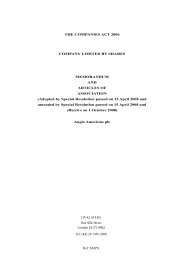
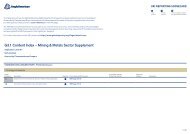
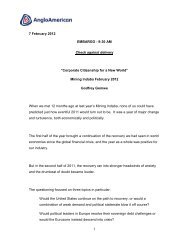
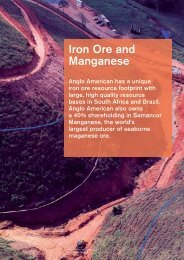
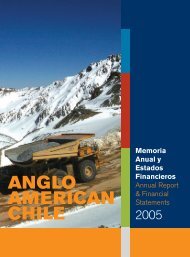
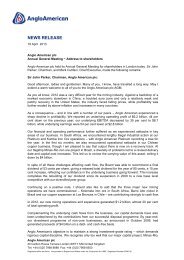
![English PDF [ 189KB ] - Anglo American](https://img.yumpu.com/50470814/1/184x260/english-pdf-189kb-anglo-american.jpg?quality=85)
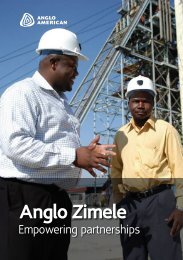

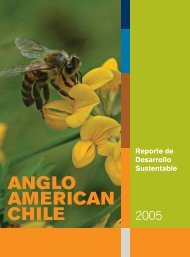

![pdf [ 595KB ] - Anglo American](https://img.yumpu.com/49420483/1/184x260/pdf-595kb-anglo-american.jpg?quality=85)
